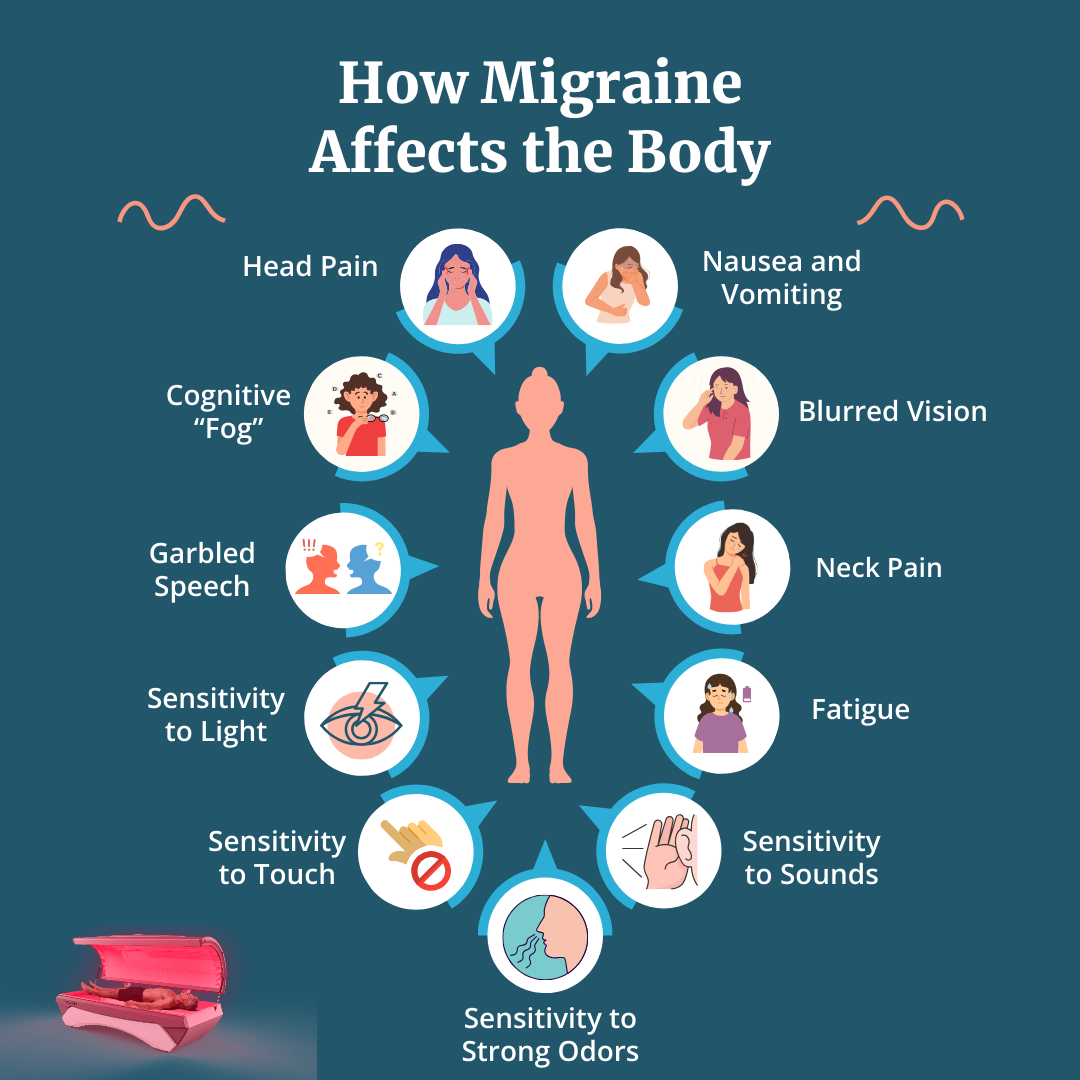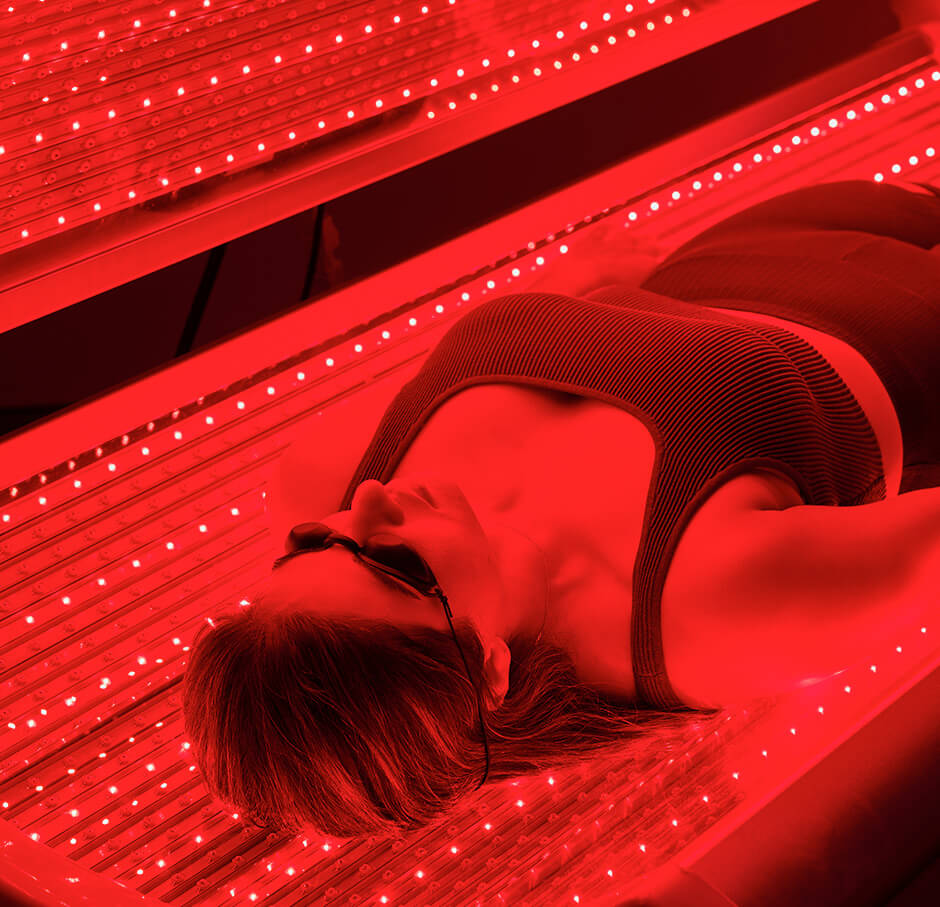Migraine Relief with Red Light Therapy

1-What is Migraine?
Migraines are not merely headaches, they are a complex neurological condition characterized by debilitating symptoms such as severe throbbing pain, hypersensitivity to light and sound, and often nausea and vomiting. This condition significantly impacts the daily lives of sufferers, limiting their ability to perform routine tasks and diminishing their quality of life. While traditional management strategies offer relief to some, many continue to search for more effective and less invasive solutions. In this context, Red Light Therapy (RLT) emerges as a promising approach, offering a non-invasive, innovative method to manage and alleviate the symptoms of migraines.

2-Red Light Therapy for Migraines.
Red Light Therapy (RLT) plays a crucial role in modulating inflammation, a key player in the pathophysiology of migraines. By reducing the production of pro-inflammatory cytokines and enhancing the levels of anti-inflammatory cytokines, RLT addresses the inflammatory processes that contribute to the development and persistence of migraine episodes. Additionally, RLT promotes vasodilation, improving blood flow and reducing the vasospasm that often triggers migraine pain. This therapy also influences the peripheral and central nervous systems, modulating pain perception pathways and potentially decreasing the severity and frequency of migraine attacks.
As we explore the benefits of Red Light Therapy for migraines, this article aims to provide a comprehensive overview of how RLT serves as an option for those afflicted by this challenging condition. Through a blend of scientific evidence and practical advice, we will explore the mechanisms by which RLT offers relief and the potential it holds for enhancing the well-being of individuals suffering from migraines.

The efficacy of Red Light Therapy (RLT), also known as Low-Level Laser Therapy (LLLT), in managing migraine symptoms is supported by a growing body of scientific evidence. These studies talks about RLT’s potential to not only alleviate pain but also to reduce the reliance on medication for migraine sufferers, highlighting its role as a promising non-pharmacological intervention.
A pivotal study, titled “APPLYING OF LOW LEVEL LASER THERAPY (LLLT) FOR PAIN MANAGEMENT IN MIGRAINE,” provides valuable insights into the effectiveness of LLLT in the context of migraines. The research findings suggest, “LLLT can be applied for pain attenuation and reduction in drug consumption successfully in migraine.“[1] This statement highlights the dual benefits of LLLT in not only managing pain but also in potentially reducing the need for medication. Such an outcome is particularly significant for individuals seeking alternatives to pharmacological interventions, which often come with side effects or the risk of medication overuse headaches.
Further evidence of LLLT’s efficacy in treating migraines comes from a study comparing the effects of Botulinum toxin A (BT-A) and LLLT in chronic migraine treatment. The study, titled “Botulinum toxin A (BT-A) versus low-level laser therapy (LLLT) in chronic migraine treatment: a comparison,” reveals compelling results favoring LLLT. The research notes, “In the LLLT group, the number of headache days sharply decreased, when the baseline was compared with the treatment phase (p < 0.001) with further decrease in the post-treatment phase (p < 0.001), showing a long-lasting effect of LLLT in CM (chronic migraine).“[1]
A clinical study titled “Light Therapy Modulates Serotonin Levels and Blood Flow in Women with Headache: A Preliminary Study” sheds light on the physiological effects of Low-Level Laser Therapy (LLLT) on individuals suffering from tension-type headaches. The research findings are particularly compelling, revealing that “Within the scope of our study, we conclude that LLLT has an immediate biological effect on local circulation when applied over the injured area and that 5-HT (serotonin) levels are augmented until three days following LLLT in patients with tension-type headache.“[2]
This highlights the dual benefits of LLLT in enhancing local blood flow and increasing serotonin levels, a crucial neurotransmitter involved in the modulation of pain and mood, providing insight into the mechanisms through which LLLT can offer relief to those suffering from chronic headaches and migraines.
This finding highlights not only the immediate benefits of LLLT in reducing the frequency of migraine days but also its sustained effects beyond the treatment period, offering a great alternative for chronic migraine sufferers.
These studies collectively affirm the potential of LLLT as a valuable tool in the migraine management toolkit. The ability of LLLT to diminish pain, reduce the frequency of migraine days, and potentially lessen dependence on medications addresses key concerns for those affected by this debilitating condition. The indication of long-lasting effects post-treatment suggests that LLLT could offer sustained relief, contributing to an overall improvement in quality of life for migraine sufferers.
4-Practical Considerations for Using Red Light Therapy for Migraines
When considering Red Light Therapy (RLT) as a part of a comprehensive strategy for managing migraines, several practical considerations must be taken into account to ensure the therapy is both effective and safe. RLT’s potential to enhance cellular function, reduce inflammation, improve blood flow, and modulate pain perception makes it a promising option for migraine sufferers. However, optimizing the benefits of RLT involves careful attention to device selection, treatment protocols, and safety guidelines.
5-CHOOSING THE RIGHT DEVICE
The effectiveness of RLT can vary significantly based on the device used. Key factors to consider when selecting a device include:
- (1) Wavelength: The most effective wavelengths for RLT fall within the red to near-infrared light spectrum, typically between 630nm, 660nm, 810nm, 850nm and 940nm for migraines. These wavelengths have the optimal penetration depth and are most effective in stimulating the desired photobiomodulation effects. Consult our Wavelength Benefits Guide for information on specific conditions.
- (2) Power Density: Also known as irradiance, this refers to the power output per unit area of the device. A balance is crucial here; too low may be ineffective, while too high could risk tissue damage or discomfort.
- (3)Treatment Area Size: Depending on whether migraines are localized or involve larger areas of the head, the size of the light-emitting surface of the device can play a role in its effectiveness.


[1] Loeb LM, Amorim RP, Mazzacoratti MDGN, Scorza FA, Peres MFP. Botulinum toxin A (BT-A) versus low-level laser therapy (LLLT) in chronic migraine treatment: a comparison. Arq Neuropsiquiatr. 2018 Oct;76(10):663-667. doi: 10.1590/0004-282X20180109. PMID: 30427505.
[2] Tomaz de Magalhães M, Núñez SC, Kato IT, Ribeiro MS. Light therapy modulates serotonin levels and blood flow in women with headache. A preliminary study. Exp Biol Med (Maywood). 2016 Jan;241(1):40-5. doi: 10.1177/1535370215596383. Epub 2015 Jul 22. PMID: 26202374; PMCID: PMC4935433
